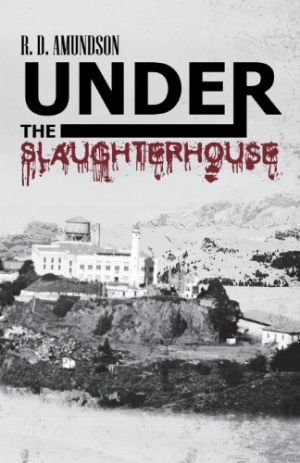Under the Slaughterhouse
Author orchestrates a compelling symphony of mounting tension in a thrilling tale that weaves together the ancient and the modern.
R. D. Amundson’s clever unraveling and reweaving of ancient Celt and Viking folklore binds two modern heirs of these tales, Truman and Laura, in a complex fabric of dreams, prophecies, and mortal combat with their demonic counterparts. In his second novel, Under the Slaughterhouse, Amundson demonstrates a talent for both storytelling and character development. But it is his pacing and deft maneuvering between centuries that are most satisfying.
Truman Struck, a reflective new inmate in a remote northern Montana prison, finds his attention increasingly drawn to the abandoned slaughterhouse perched on rugged foothills outside his cell window. Truman’s contemplation of the smothering banality of prison life is suddenly interrupted by a series of bizarre dreams and visions—horrific beasts attack him while phase-shifting demons taunt him.
Truman’s fellow inmates, including shamans of indigenous Lakota Sioux, nod in recognition at his recounting of the dreams. “Spirits walk the hallways,” Medicine Horse warns. “Hoka-Hey, it is a good day to die.”
The prison’s GED program director, Laura Witherby, a young woman from town, appreciates Truman’s help as teacher’s aid. She enjoys his company as well as their discussions about the importance of good books and a good education. Not coincidentally, Laura has also experienced mystical, frightening dreams and visions. Her dreams are usually either preceded or interrupted by enormous gatherings of ravens above her home and on the razor wire surrounding the prison.
Amundsen’s story line builds momentum as Laura and Truman surmise their dreams are possibly a call to arms from a prophecy immortalized centuries earlier by distant relatives: Celtic Warrior Queen Lucretia and her Viking adversary, Buckwold the Slayer. Amundson directs a spellbinding discovery process for the descendants that is akin to peeling away layers of an onion. Laura and Truman are transformed by this experience—prisoner to warrior, lonely teacher to combat strategist.
With cryptic guidance from the Lakota shamans, Laura and Truman learn it is their fate to confront the Dark One, the timeless summation of Evil that has been trapped for millennia below the snow and granite outcroppings of the Continental Divide, and more recently in the tunnels below the prison and slaughterhouse.
Amundson writes, “The thing in the tunnel knew Truman wouldn’t scare easily. … Possessed with the patience of a viper, driven by the hunger of a lion, it is the perfect predator, but it does not crave flesh dripping hot with fear-laced blood. … It feeds on souls.”
The author orchestrates a compelling symphony of mounting tension in the tunnels that erupts without warning in violent skirmishes between mortals and minions of the Dark One. “Evil never dies you know,” according to the shamans, and the Dark One has been planning a ravaging, gluttonous coming-out party for some time.
This subject matter and presentation are appropriate for adults and mature young teens.
Reviewed by
R. L. McCreery
Disclosure: This article is not an endorsement, but a review. The publisher of this book provided free copies of the book and paid a small fee to have their book reviewed by a professional reviewer. Foreword Reviews and Clarion Reviews make no guarantee that the publisher will receive a positive review. Foreword Magazine, Inc. is disclosing this in accordance with the Federal Trade Commission’s 16 CFR, Part 255.

